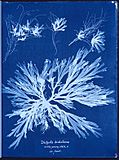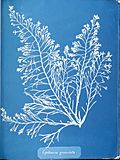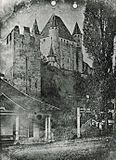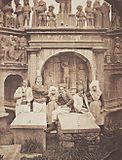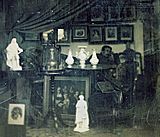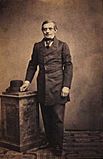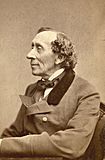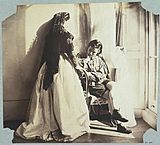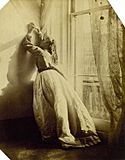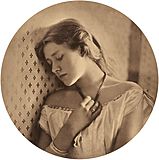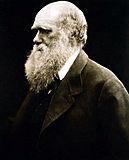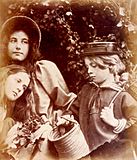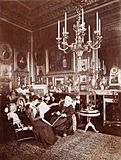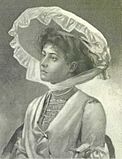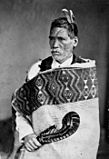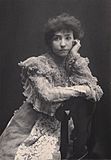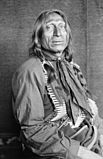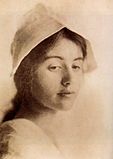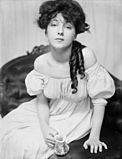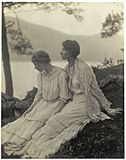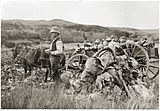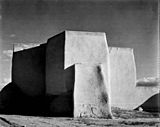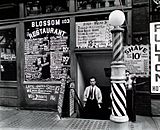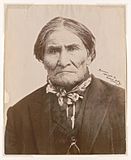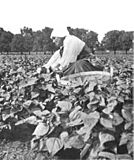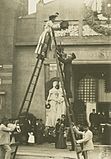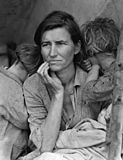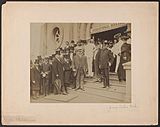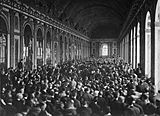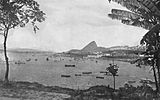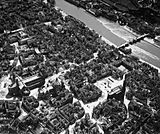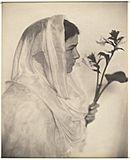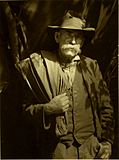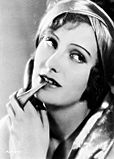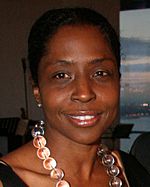Women photographers facts for kids
The story of women in photography goes all the way back to when photography first began! Many of the earliest women photographers, mostly from Britain or France, were connected to the men who first developed photography.
It was in northern Europe that women first started photography businesses. They opened studios in places like Denmark, France, Germany, and Sweden starting in the 1840s. In Britain, women from wealthy families began to see photography as an art form in the late 1850s. It wasn't until the 1890s that the first photography studios run by women opened in New York City.
Later, groups like Britain's The Linked Ring and America's Photo-Secession (started by Alfred Stieglitz) helped photography become seen as an art. Many women joined these groups. In Vienna, Dora Kallmus made her photography studios popular meeting places for important people.
In the United States, women first took photos as a hobby. Many created amazing work that was shown in big exhibitions. They photographed famous people and Native Americans, and also took pictures of landscapes, especially from the early 1900s. Women also started working in photojournalism (taking pictures for newspapers and magazines) in the early 1900s, and this grew during World War I.
Contents
- Early Photographers
- The Pictorialists
- Women Photographers from Vienna
- Landscapes and Street Photography
- Surrealism in Photography
- Evolving American Participation
- African-American Women in Photography
- International Women Photographers After the 1950s
- UK Women's Agency
- 21st Century Photographers
- Awards
- Images for kids
- See also
Early Photographers
While we know a lot about the men who developed photography, the role women played in the early days is often less talked about.
The Very Beginning
Women were involved in photography right from the start. Constance Fox Talbot, whose husband Henry Fox Talbot was a key person in developing photography in the 1830s and 1840s, tried out the process herself in 1839. Some believe she took the earliest known photo by a woman.
Anna Atkins, a botanist (someone who studies plants), learned about photography from Fox Talbot. She also learned about the cyanotype process, which uses chemicals to create blue prints. She used this to make pictures of dried algae in 1843. She published these in a book, which is thought to be the first book ever with photographic illustrations!
Another botanist, John Dillwyn Llewelyn, might have learned photography from his wife, Emma Thomasina Talbot. She was a cousin of Fox Talbot and was very interested in photography. She also did all of her husband's photo printing.
-
Anna Atkins: "Dictyota dichotoma, in the young state; and in fruit" (cyanotype, 1843)
First Professional Photographers
In Switzerland, Franziska Möllinger started taking daguerreotypes (early photos on metal plates) of Swiss views around 1842. She also took portraits for money starting in 1843. About 20 years later, Alwina Gossauer became one of the first professional women photographers.
In France, Geneviève Élisabeth Disdéri was an early professional. She and her husband opened a daguerreotype studio in Brest in the late 1840s. When her husband left, she continued to run the business by herself.
Bertha Wehnert-Beckmann was likely Germany's first professional female photographer. She opened a studio in Leipzig in 1843 with her husband. After he died in 1847, she ran the business alone. Emilie Bieber opened a daguerreotype studio in Hamburg in 1852. She ran it until 1885. In the United States, Sarah Louise Judd is said to have made daguerreotypes in Minnesota as early as 1848.
In Sweden, women also started photography businesses early. Brita Sofia Hesselius took daguerreotypes in Karlstad in 1845. Marie Kinnberg was one of the first to use the new photo technique in Gothenburg in 1851–52. Hilda Sjölin became a professional photographer in Malmö in 1860. By the 1860s, there were at least 15 confirmed female photographers in Sweden. Three of them, Rosalie Sjöman, Caroline von Knorring, and Bertha Valerius, were among the best in their field.
Thora Hallager, one of Denmark's earliest women photographers, worked in Copenhagen from the early 1850s. She is famous for a great portrait of Hans Christian Andersen she took in 1869. In Norway, Marie Magdalene Bull opened her studio in the 1850s.
In Finland, Caroline Becker and Hedvig Keppler both opened studios in 1859. Julia Widgrén became Finland's first famous female photographer in the late 1860s. The Netherlands had its first professional female photographer in the same decade. Maria Hille worked with her husband and then managed his studio herself after he passed away in 1863.
-
Thun Castle, daguerreotype by Franziska Möllinger (around 1844)
-
Geneviève Élisabeth Disdéri: Cimetière de Plougastel (1856)
-
Bertha Wehnert-Beckmann: The Wehnert-Beckmann studio (around 1850)
-
Hilda Sjölin: Portrait of Ida Hultgren (1863)
-
Thora Hallager: Niels Frederik Larsen (1863)
Pioneering Artists
Two British women are known for their early artistic photography. In the late 1850s, Lady Clementina Hawarden started taking photos. She specialized in portraits, especially of her daughters. Her work won silver medals at exhibitions in 1863 and 1864.
Even more famous for artistic work is Julia Margaret Cameron. She started photography in 1863 when she was 48. She wanted photography to be seen as a real art form. She took many portraits of children and famous people. She often used a "soft focus" style, which was criticized then but is now loved. It even helped start the Pictorialism movement later on.
Caroline Emily Nevill and her sisters showed their photos in London in 1854. They took pictures of buildings in Kent. In Italy, Virginia Oldoini became interested in photography in 1856. She took hundreds of self-portraits, often in costumes, to record her life.
-
Clementina Hawarden: Her costumed daughters Clementina Maude and Isabella (1861)
-
Julia Margaret Cameron: "Sadness" (1864)
19th Century Studio Work
The first known photography studios run by women in English-speaking countries opened in the 1860s. Before that, women had already opened studios in France, Germany, Denmark, and Sweden.
In the 1860s and 1870s, women ran their own studios in Malta. Sarah Ann Harrison operated her studio from 1864 to 1871. Adelaide Conroy worked with her husband and then alone from 1872 to around 1880.
Around 1866, Shima Ryū and her husband opened a studio in Tokyo, Japan. In New Zealand, Elizabeth Pulman helped her husband in his Auckland studio from 1867. After he died in 1871, she continued to run the business until 1900.
In Beirut, Lebanon, Marie-Lydie Bonfils and her husband opened the first photography studio there in 1867. It's believed Lydie took many portraits of women, as women photographers were preferred for privacy reasons. Lydie ran the studio after her husband's death in 1885 until 1914.
Many Danish women quickly opened their own studios. Frederikke Federspiel opened a studio in Aalborg in the mid-1870s. Mary Steen opened her Copenhagen studio in 1884. She soon became Denmark's first female court photographer, taking pictures of royalty. Benedicte Wrensted opened a studio in Horsens in the 1880s before moving to the United States, where she photographed Native Americans.
After studying photography in London, Alice Hughes opened a studio in 1891. She quickly became a top photographer of royalty, fashionable women, and children. At her busiest, she had 60 women working for her and took up to 15 photo sessions a day!
One of the first women to open a studio in New York City was Alice Boughton. She opened her studio in 1890 and became one of the city's most respected portrait photographers. Zaida Ben-Yusuf, who moved from Britain to the U.S. in 1895, opened a portrait studio in New York in 1897 where she photographed celebrities.
-
Mary Steen: Queen Victoria with Princess Beatrice at Windsor Castle (1895)
-
Frederikke Federspiel with a client in her Aalborg studio (1910)
-
Alice Hughes: Pauline Waldorf Astor (1904)
-
Elizabeth Pulman: Rewi Manga Maniapoto (1879)
-
Zaida Ben-Yusuf: Mrs. Fiske, 'Love finds the way' (1896)
Women Photographers in America
There are many stories of women running studios alone or with their husbands in America, even before the 1860s. For example, Mrs. Elizabeth Beachbard closed her studio in New Orleans to photograph soldiers during the American Civil War. She sadly passed away there in 1861.
After the 1920s, the number of women photographers grew a lot, with about 5,000 estimated. Even with some limits on what women could do, photography allowed them to be creative. New opportunities appeared, like magazines such as "American Amateur Photographer," which helped women photographers show their skills. The rise of women in photography happened during a time when women's roles in society were changing a lot. Many women photographers were part of photography groups during this period.
The Pictorialists
Photography as an art form existed early on. But it was around the late 1800s and early 1900s, thanks to Alfred Stieglitz in America, that its artistic side, called pictorialism, became widely known.
Among Stieglitz's closest friends were Gertrude Käsebier and Eva Watson-Schütze. They both turned to photography after studying art and wanted to make photography more artistic. They helped start the Photo-Secession movement in 1902. They took beautiful, well-composed portraits that were shown in important exhibitions. Käsebier is also known for her portraits of Native Americans and became one of the most famous professional photographers in the U.S.
Other important pictorialists included Alice Boughton and Anne Brigman. Mary Devens experimented with printing techniques and, like Käsebier, became a member of the British The Linked Ring group, which also promoted photography as art. The German-born Canadian Minna Keene was another early female member of the Linked Ring.
-
Gertrude Käsebier: Chief Iron Tail (1898)
-
Alice Boughton: Two Women under a Tree (1906)
Women Photographers from Vienna
In Vienna before World War I, there were more photo studios run by women than by men. About 40 women had studios there. The most famous was Dora Kallmus, known as Madame d'Ora. She joined the Vienna Photographic Society in 1905 and opened a studio in 1907. She became very successful with important families in Austria-Hungary. She then opened a second studio in Paris and became a top photographer for society and fashion in the 1930s. Her studios were also popular meeting places for thinkers and artists.
Other women photographers who had successful careers in Vienna included Trude Fleischmann and Claire Beck, who sadly died during a difficult time in history. Margaret Michaelis-Sachs, who later moved to Australia, also started her photography career in Vienna. She is remembered for her photos of the Jewish market in Krakow in the 1930s.
Landscapes and Street Photography
Sarah Ladd began taking landscape photos in Oregon in the late 1800s. Her pictures of the Columbia River, which she developed in a darkroom on a houseboat, were shown in a museum in 2008. British-born Evelyn Cameron took many clear photos of Montana and its people in the late 1800s. Her work was rediscovered in the 1970s and published in a book.
Laura Gilpin, who was mentored by Gertrude Käsebier, is known for her photos of Native Americans and Southwestern landscapes, especially from the 1930s. Berenice Abbott is famous for her black-and-white photos of New York City from 1929 to 1938. Much of her work was part of a government art project. Her book Changing New York (1939) shows many buildings and neighborhoods of Manhattan that no longer exist.
In Mexico, Lola Álvarez Bravo is remembered for her portraits and artistic photos that helped preserve her country's culture. Her work is in major museums worldwide. She once said, "If my photographs have any meaning, it's that they stand for a Mexico that once existed."
-
Evelyn Cameron: Alec Flower, her brother (1898)
-
Laura Gilpin: Mission Church at Rancho de Taos (1930)
-
Berenice Abbott: Blossom Restaurant, New York (1935)
Photojournalism and Documentary Work
The Library of Congress has millions of photos made for magazines and newspapers. You can search for images taken by women photojournalists there.
Early Photojournalists
Canadian-born Jessie Tarbox is thought to be America's first female photojournalist. She photographed a prison for a newspaper in 1899. She was then hired by other newspapers in 1902. Zaida Ben-Yusuf was a woman who earned a living independently, which was rare for women at the time. The Gerhard Sisters opened their own photo studio in St. Louis in 1903, and their photos often appeared in local and national news.
-
Geronimo (Gerhard Sisters, around 1904)
-
Weeding beans on a Dutch truck farm outside Winnipeg, Manitoba (Edith S. Watson, around 1918)
-
Jessie Tarbox Beals at work (1904)
Other Important Photojournalists
Harriet Chalmers Adams was an explorer whose photos were published in National Geographic. She was a reporter for Harper's Magazine in Europe during World War I. She was the only female journalist allowed to visit the trenches. Another war reporter in France during World War I was Helen Johns Kirtland, who worked for Leslie's Weekly.
Imogen Cunningham is known for her photos of plants and industrial scenes. She was part of Group f/64, a group known for clear, sharp photos of simple subjects. Margaret Bourke-White was the first foreigner to photograph Soviet industry. She was also the first female war reporter and the first woman photographer for Life magazine.
During the Great Depression, Dorothea Lange was hired by the government to photograph struggling farm families and migrant workers. Her photos, given free to newspapers, became famous symbols of that difficult time. The writer Eudora Welty also photographed families affected by the Great Depression, especially in rural Mississippi.
In the early 1930s, Marvin Breckinridge Patterson published her travel photos in many popular magazines like Vogue and National Geographic. Marion Carpenter was the first female national press photographer and the first woman to cover the White House. Edie Harper was an Army photographer during WWII, taking pictures of structures like dams. Her war photos were highly praised.
Mary Ellen Mark (1940–2015) was an American photographer known for her photojournalism, portraits, and documentary work. She focused on people "away from mainstream society." She published 18 books, including Streetwise and Ward 81. Her photos appeared in major magazines like Life and The New Yorker. She won many awards for her work. Vivian Maier (1926–2009) took over 150,000 photos, mostly of people and street scenes in Chicago and New York in the 1950s and 1960s. She only became famous after her death in the early 2000s.
-
Dorothea Lange: Migrant Mother (1936)
-
Jessie Tarbox Beals: William Howard Taft at the St. Louis World's Fair (1904)
-
Harriet Chalmers Adams: Rio de Janeiro's waterfront and the Morro de Castello from the Ilha das Cobras (1919)
-
Margaret Bourke-White: Aerial photo of the destroyed Wurzburg (1945)
Surrealism in Photography
Many women used photography to show their interest in Surrealism, an art movement that explores dreams and imagination. Claude Cahun (1894–1954) from France is known for her self-portraits, which she started taking in the 1920s. She used them to explore ideas of identity and gender.
Croatian-born Dora Maar (1907–1997) also became interested in Surrealism in France. Her vivid portraits from the early 1930s make faces look like they were drawn by an artist. The American Lee Miller (1907–1977) combined her fashion photography with Surrealism.
Surrealism continued to interest women photographers in the second half of the 20th century. Henriette Grindat (1923–1986) was one of the few Swiss women to focus on artistic photography. She worked with writer Albert Camus on a book about a river in France. From the late 1940s, the Czech Emila Medková (1928–1985) created surrealistic photos, especially documentary images of cities after the war.
Although not strictly a Surrealist, the Mexican photographer Lola Álvarez Bravo (1907–1993) showed elements of Surrealism in her work, especially in her portraits of famous artists like Frida Kahlo. During her short life, Francesca Woodman (1958–1981) explored the connection between the body and its surroundings, often showing herself partly hidden in her black-and-white photos.
Evolving American Participation
A researcher named Peter E. Palmquist found that in the 19th century, about 10% of all photographers in the U.S. were women. By 1910, this number grew to about 20%. In the early days, most women working professionally were married to photographers. Before 1890, any woman working on her own was seen as very brave. As photography became easier, more people took it up as a hobby, and many joined photography groups. Even in the 20th century, it was still challenging for women to become very successful photographers.
Portraits
Marian Hooper Adams (1843–1885) was one of America's earliest portrait photographers. She took pictures of family, friends, and politicians from 1883 and did all her own developing. Sarah Choate Sears (1858–1935) became famous internationally as a hobby photographer after taking beautiful portraits and flower studies. She joined important photography groups in London and New York.
Elizabeth Buehrmann from Chicago (around 1886–1963) specialized in taking portraits of important businesspeople and society women in their homes in the early 1900s. Caroline Gurrey (1875–1927) is known for her photos of mixed-race children in Hawaii from 1904. Many were shown at a big exhibition in Seattle. Doris Ulmann (1884–1934) started as a hobby photographer but became a professional in 1918. Besides portraits of famous thinkers, she photographed people in the mountains of the south, especially the Appalachians.
In the 1930s, Consuelo Kanaga (1894–1978) photographed many well-known artists and writers. She was one of the few photographers to create artistic portraits. Her photo of a slender Black woman and her children was included in a famous exhibition called The Family of Man in 1955. Ruth Harriet Louise (1903–1940) was the first woman photographer in Hollywood. She ran Metro-Goldwyn-Mayer's portrait studio from 1925 to 1930, photographing many stars like Greta Garbo and Joan Crawford.
-
Doris Ulmann: Southern Mountaineer (around 1928)
-
Ruth Harriet Louise: Greta Garbo (1927)
African-American Women in Photography
History and Impact
Photographs show us things and tell us stories. As society changed, African-American photographers were very important in showing real and true pictures of Black culture. African-American women in photography started to get more recognition in the mid-20th century. With this growing recognition, they began to focus on social, economic, and political issues in their work. Some of the most famous female African-American photographers include Carrie Mae Weems, Lorna Simpson, and Coreen Simpson.
Carrie Mae Weems
Born in Portland, Oregon, Carrie Mae Weems got her first camera in 1973. She was interested in art from 1965, when she started doing street theater and dance. Weems is a great photographer, but her work also includes text, fabric, audio, digital images, and video. She has said she is interested in "power and the consequences of power." Weems often uses herself in her photos, not for her own fame, but to explore ideas about power.
Through her different art forms, Weems wants to explore family relationships, gender roles, and the histories of racism, sexism, and different political systems. She became good friends and colleagues with photographer Dawoud Bey in 1976.
Susan "Sue" Ross
Sue Ross helped start Sistagraphy, a group of women photographers, mostly from Atlanta, Georgia, who love photography. In Atlanta, Sue is known as the PhotoGriot, meaning she shares stories of the African American community through her photos. Sue has captured cultural events, programs, and important leaders like Nelson Mandela and the past six African American Mayors of Atlanta. Since 1985, her work has been shown in many places around Atlanta.
Lorna Simpson
Lorna Simpson started her career in fashion photography, taking pictures of people whose style she liked. Simpson improved her skills and became a photojournalist, capturing images in politics, culture, music, and sports.
Lorna Simpson studied photography in New York and California. She was seen as a pioneer in "conceptual photography" (photography that explores ideas) even before she became very famous. Through her work, Simpson wants to challenge common ideas about gender, identity, culture, history, and memory. Her large photos combined with meaningful text create powerful visual messages.
Her work can be found in museums across the country and around the world, including the Museum of Modern Art in New York.
Coreen Simpson
Coreen Simpson started as a writer before becoming a photojournalist. Her interest in writing about experiences grew into a love for visual arts. She contacted a magazine about an article, and even though it wasn't published, it sparked her interest in photojournalism.
Through her photos, Simpson creates visual stories that beautifully show the lives of different groups of people. She can make people feel emotions through her storytelling, and also through her use of design, light and shadow (chiaroscuro), and color.
Simpson's friend, Walter Johnson, was a big mentor to her. She also studied the work of Frank Stewart and learned a lot about the history of photography. One of her biggest challenges was to make her own visual style different from the photographers who inspired her.
Four photographers greatly influenced Simpson's work: Diane Arbus, Baron Adolph DeMeyer, Joel Peter Witkin, and Weegee. Each of them helped shape her approach to photography in different ways, whether in ideas, methods, or creativity.
Elizabeth "Tex" Williams
Elizabeth "Tex" Williams was a World War II military photographer, working in the last year of the war. She was one of the first women to have a photography career beyond just being a "camera girl."
International Women Photographers After the 1950s
In the second half of the 20th century, magazines like National Geographic and photo books became very popular worldwide. Some women photojournalists became famous for their work in interesting places and with different cultures.
Leni Riefenstahl, a German filmmaker who made films for the German government in the 1930s and 1940s, turned to photography in the 1960s. In her second career, she became known for her pictures of tribal life in southern Sudan. She published books like Die Nuba and Die Nuba von Kau. She also photographed the 1972 Summer Olympics in Munich and took photos of underwater life and celebrities.
Among 14 books by American photographer Carol Beckwith and Australian Angela Fisher, there are photos of the Dinka people in southern Sudan and other African groups like the Maasai. They are known for their beautiful pictures of the Dinka's ancient ways of raising cattle. Margaret Courtney-Clarke (born 1949) is a Namibian documentary photographer. Her work often explores how communities survive in the changing landscapes of Namibia. She has made three books about the art of African women.
Graciela Iturbide (born 1942) from Mexico has had many exhibitions and international recognition since the 1970s. She is known for her black-and-white photos of Mexican women, often showing scenes from native communities.
UK Women's Agency
In the United Kingdom, a photography agency called Format was started in 1983. It was created by Maggie Murray and Val Wilmer. Format operated for 20 years, until 2003, and represented many women photographers.
21st Century Photographers
Today, women photographers continue to make new discoveries in photography. Annie Leibovitz takes striking, often posed, pictures of famous people and everyday people. Her photos appear on the covers of magazines like Vanity Fair, Vogue, and Rolling Stone. Her work shows a wide range of American popular culture.
Cindy Sherman's work turns still photography into performance art. She uses it to explore traditional and pop-culture ideas of femininity. Her work looks at identity, stereotypes, how mass media works, and the nature of portraits.
There are many contemporary women photographers. Some notable ones born in the 1950s and early 1960s include: Rineke Dijkstra, Nan Goldin, Jitka Hanzlová, An-My Lê, Vera Lutter, Sally Mann, Bettina Rheims, Ellen von Unwerth, JoAnn Verburg, and Carrie Mae Weems. Younger contemporary photographers (born in the early 1970s) include Lynsey Addario, Rinko Kawauchi, Hellen van Meene, Zanele Muholi, Viviane Sassen, and Shirana Shahbazi. Some recent contemporary photographers include Petra Collins, Juno Calypso, Delphine Fawundu, Shirin Neshat, Sophie Calle, Laura Aguilar, and Genevieve Cadieux. These are just some of the many talented women working in photography today.
Awards
In 1903, Emma Barton (1872–1938) was the first woman to receive the Royal Photographic Society medal. She won it for a photo called The Awakening.
The Pulitzer Prize for Photography has been given for excellent press photography since 1942. The first woman to win this award was Virginia Schau (1915–1989). She was a hobby photographer who took a picture of two men being rescued from a truck hanging off a bridge in Redding, California.
In 2000, Marcia Reed (born 1948) became the first female still photographer to join the International Cinematographers Guild. She also became the first woman to win the Society of Operating Cameramen Lifetime Achievement Award for Still Photography in 2000.
Images for kids
See also
 In Spanish: Mujeres fotógrafas para niños
In Spanish: Mujeres fotógrafas para niños
- List of women photographers
- Timeline of women in photography


